The 2020 Mac Mini Unleashed: Putting Apple Silicon M1 To The Test
by Andrei Frumusanu on November 17, 2020 9:00 AM ESTSection by Ryan Smith
M1 GPU Performance: Integrated King, Discrete Rival
While the bulk of the focus from the switch to Apple’s chips is on the CPU cores, and for good reason – changing the underlying CPU architecture if your computers is no trivial matter – the GPU aspects of the M1 are not to be ignored. Like their CPU cores, Apple has been developing their own GPU technology for a number of years now, and with the shift to Apple Silicon, those GPU designs are coming to the Mac for the very first time. And from a performance standpoint, it’s arguably an even bigger deal than Apple’s CPU.
Apple, of course, has long held a reputation for demanding better GPU performance than the average PC OEM. Whereas many of Intel’s partners were happy to ship systems with Intel UHD graphics and other baseline solutions even in some of their 15-inch laptops, Apple opted to ship a discrete GPU in their 15-inch MacBook Pro. And when they couldn’t fit a dGPU in the 13-inch model, they instead used Intel’s premium Iris GPU configurations with larger GPUs and an on-chip eDRAM cache, becoming one of the only regular customers for those more powerful chips.
So it’s been clear for some time now that Apple has long-wanted better GPU performance than what Intel offers by default. By switching to their own silicon, Apple finally gets to put their money where their mouth is, so to speak, by building a laptop SoC with all the GPU performance they’ve ever wanted.
Meanwhile, unlike the CPU side of this transition to Apple Silicon, the higher-level nature of graphics programming means that Apple isn’t nearly as reliant on devs to immediately prepare universal applications to take advantage of Apple’s GPU. To be sure, native CPU code is still going to produce better results since a workload that’s purely GPU-limited is almost unheard of, but the fact that existing Metal (and even OpenGL) code can be run on top of Apple’s GPU today means that it immediately benefits all games and other GPU-bound workloads.
As for the M1 SoC’s GPU, unsurprisingly it looks a lot like the GPU from the A14. Apple will have needed to tweak their design a bit to account for Mac sensibilities (e.g. various GPU texture and surface formats), but by and large the difference is abstracted away at the API level. Overall, with M1 being A14-but-bigger, Apple has scaled up their 4 core GPU design from that SoC to 8 cores for the M1. Unfortunately we have even less insight into GPU clockspeeds than we do CPU clockspeeds, so it’s not clear if Apple has increased those at all; but I would be a bit surprised if the GPU clocks haven’t at least gone up a small amount. Overall, A14’s 4 core GPU design was already quite potent by smartphone standards, so an 8 core design is even more so. M1’s integrated GPU isn’t just designed to outpace AMD and Intel’s integrated GPUs, but it’s designed to chase after discrete GPUs as well.
| A Educated Guess At Apple GPU Specifications | |||
| M1 | |||
| ALUs | 1024 (128 EUs/8 Cores) |
||
| Texture Units | 64 | ||
| ROPs | 32 | ||
| Peak Clock | 1278MHz | ||
| Throughput (FP32) | 2.6 TFLOPS | ||
| Memory Clock | LPDDR4X-4266 | ||
| Memory Bus Width | 128-bit (IMC) |
||
Finally, it should be noted that Apple is shipping two different GPU configurations for the M1. The Mac Mini and MacBook Pro get chips with all 8 GPU cores enabled. Meanwhile for the Macbook Air, it depends on the SKU: the entry-level model gets a 7-core configuration, while the higher-tier model gets 8 cores. This means the entry-level Air gets the weakest GPU on paper – trailing a full M1 by around 12% – but it will be interesting to see how the shut-off core influences thermal throttling on that passively-cooled laptop.
Kicking off our look at GPU performance, let’s start with GFXBench 5.0. This is one of our regular benchmarks for laptop reviews as well, so it gives us a good opportunity to compare the M1-based Mac Mini to a variety of other CPU/GPU combinations inside and outside the Mac ecosystem. Overall this isn’t an entirely fair test since the Mac Mini is a small desktop rather than a laptop, but as M1 is a laptop-focused chip, this at least gives us an idea of how M1 performs when it gets to put its best foot forward.
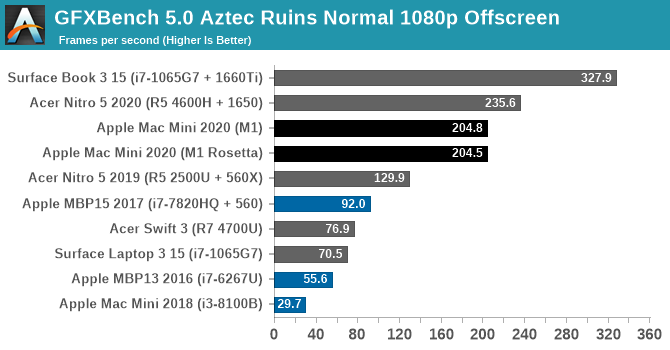
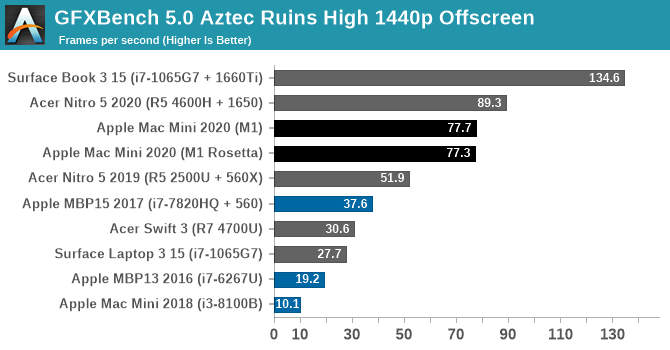
Overall, the M1’s GPU starts off very strong here. At both Normal and High settings it’s well ahead of any other integrated GPU, and even a discrete Radeon RX 560X. Only once we get to NVIDIA’s GTX 1650 and better does the M1 finally run out of gas.
The difference compared to the 2018 Intel Mac Mini is especially night-and-day. The Intel UHD graphics (Gen 9.5) GPU in that system is vastly outclassed to the point of near-absurdity, delivering a performance gain over 6x. And even other configurations such as the 13-inch MBP with Iris graphics, or a PC with a Ryzen 4700U (Vega 7 graphics) are all handily surpassed. In short, the M1 in the new Mac Mini is delivering discrete GPU-levels of performance.
As an aside, I also took the liberty of running the x86 version of the benchmark through Rosetta, in order to take a look at the performance penalty. In GFXBench Aztec Ruins, at least, there is none. GPU performance is all but identical with both the native binary and with binary translation.
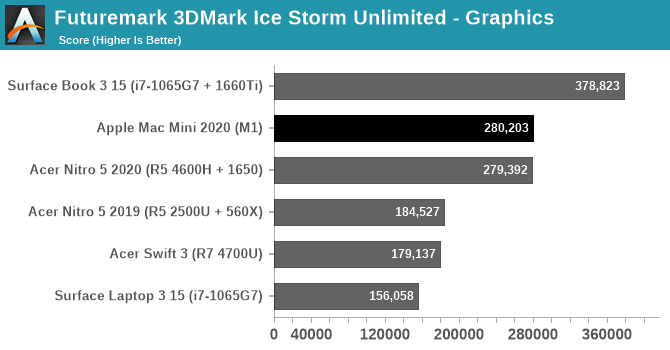
Taking one last quick look at the wider field with an utterly silly synthetic benchmark, we have 3DMark Ice Storm Unlimited. Thanks to the ability for Apple Silicon Macs to run iPhone/iPad applications, we’re able to run this benchmark on a Mac for the first time by running the iOS version. This is a very old benchmark, built for the OpenGL ES 2.0 era, but it’s interesting that it fares even better than GFXBench. The Mac Mini performs just well enough to slide past a GTX 1650 equipped laptop here, and while this won’t be a regular occurrence, it goes to show just how potent M1 can be.
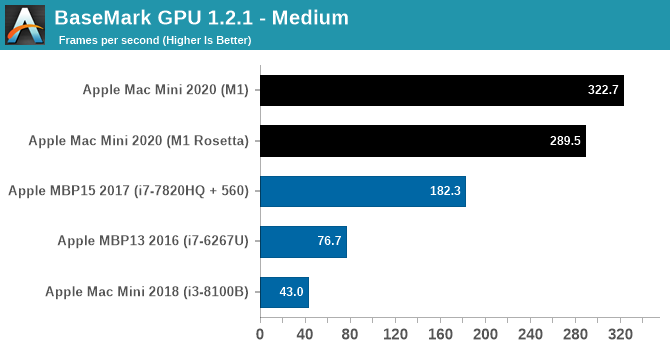

Another GPU benchmark that’s been updated for the launch of Apple’s new Macs is BaseMark GPU. This isn’t a regular benchmark for us, so we don’t have scores for other, non-Mac laptops on hand, but it gives us another look at how M1 compares to other Mac GPU offerings. The 2020 Mac Mini still leaves the 2018 Intel-based Mac Mini in the dust, and for that matter it’s at least 50% faster than the 2017 MacBook Pro with a Radeon Pro 560 as well. Newer MacBook Pros will do better, of course, but keep in mind that this is an integrated GPU with the entire chip drawing less power than just a MacBook Pro’s CPU, never mind the discrete GPU.
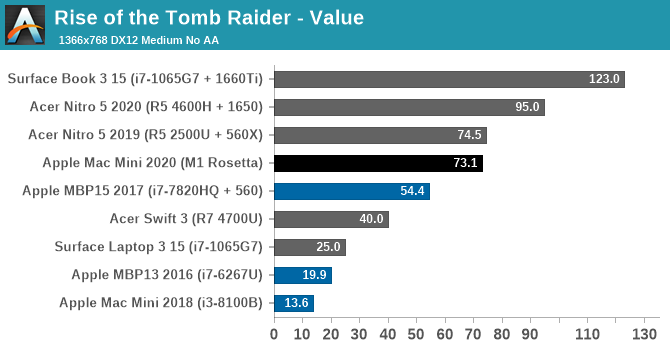
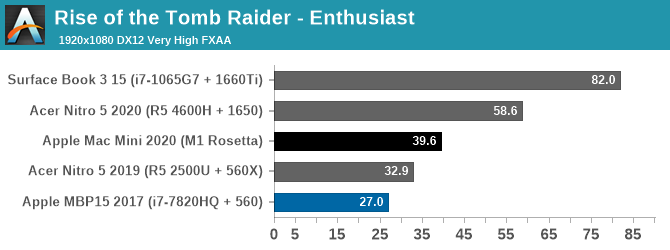
Finally, putting theory to practice, we have Rise of the Tomb Raider. Released in 2016, this game has a proper Mac port and a built-in benchmark, allowing us to look at the M1 in a gaming scenario and compare it to some other Windows laptops. This game is admittedly slightly older, but its performance requirements are a good match for the kind of performance the M1 is designed to offer. Finally, it should be noted that this is an x86 game – it hasn’t been ported over to Arm – so the CPU side of the game is running through Rosetta.
At our 768p Value settings, the Mac Mini is delivering well over 60fps here. Once again it’s vastly ahead of the 2018 Intel-based Mac Mini, as well as every other integrated GPU in this stack. Even the 15-inch MBP and its Radeon Pro 560 are still trailing the Mac Mini by over 25%, and it takes a Ryzen laptop with a Radeon 560X to finally pull even with the Mac Mini.
Meanwhile cranking things up to 1080p with Enthusiast settings finds that the M1-based Mac Mini is still delivering just shy of 40fps, and it’s now over 20% ahead of the aforementioned Ryzen + 560X system. This does leave the Mini well behind the GTX 1650 here – with Rosetta and general API inefficiencies likely playing a part – but it goes to show what it takes to beat Apple’s integrated GPU. At 39.6fps, the Mac Mini is quite playable at 1080p with good image quality settings, and it would be fairly easy to knock down either the resolution or image quality a bit to get that back above 60fps. All on an integrated GPU.
Update 11-17, 7pm: Since the publication of this article, we've been able to get access to the necessary tools to measure the power consumption of Apple's SoC at the package and core level. So I've gone back and captured power data for GFXBench Aztec Ruins at High, and Rise of the Tomb Raider at Enthusiast settings.
| Power Consumption - Mac Mini 2020 (M1) | ||||
| Rise of the Tomb Raider (Enthusiast) | GFXBench Aztec (High) |
|||
| Package Power | 16.5 Watts | 11.5 Watts | ||
| GPU Power | 7 Watts | 10 Watts | ||
| CPU Power | 7.5 Watts | 0.16 Watts | ||
| DRAM Power | 1.5 Watts | 0.75 Watts | ||
The two workloads are significantly different in what they're doing under the hood. Aztec is a synthetic test that's run offscreen in order to be as pure of a GPU test as possible. As a result it records the highest GPU power consumption – 10 Watts – but it also barely scratches the CPU cores virtually untouched (and for that matter other elements like the display controlller). Meanwhile Rise of the Tomb Raider is a workload from an actual game, and we can see that it's giving the entire SoC a workout. GPU power consumption hovers around 7 Watts, and while CPU power consumption is much more variable, it too tops out just a bit higher.
But regardless of the benchmark used, the end result is the same: the M1 SoC is delivering all of this performance at ultrabook-levels of power consumption. Delivering low-end discrete GPU performance in 10 Watts (or less) is a significant part of why M1 is so potent: it means Apple is able to give their small devices far more GPU horsepower than they (or PC OEMs) otherwise could.
Ultimately, these benchmarks are very solid proof that the M1’s integrated GPU is going to live up to Apple’s reputation for high-performing GPUs. The first Apple-built GPU for a Mac is significantly faster than any integrated GPU we’ve been able to get our hands on, and will no doubt set a new high bar for GPU performance in a laptop. Based on Apple’s own die shots, it’s clear that they spent a sizable portion of the M1’s die on the GPU and associated hardware, and the payoff is a GPU that can rival even low-end discrete GPUs. Given that the M1 is merely the baseline of things to come – Apple will need even more powerful GPUs for high-end laptops and their remaining desktops – it’s going to be very interesting to see what Apple and its developer ecosystem can do when the baseline GPU performance for even the cheapest Mac is this high.


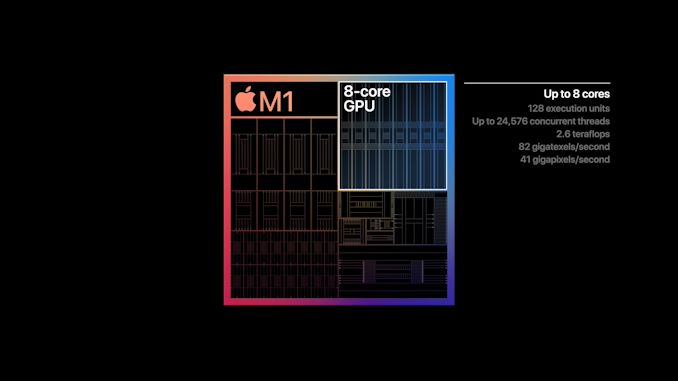








682 Comments
View All Comments
andrewaggb - Tuesday, November 17, 2020 - link
Pretty much. There's no reason to think the cores will be better on a chip with more of them. The only thing that is a possibility (certainly not a given) is that the clock speed will be substantially higher which should put Apple in the lead. That said, the previous review showed a very modest IPC improvement this time around even with huge reorder buffers and an 8-wide design. So I suspect apple's best course for improved performance is higher clocks but that always runs counter to power usage so we'll see. AMD and Intel will probably have to go wider to compete with Apple for single thread IPC in the long run.GPU-wise it's pretty decent for integrated graphics but if you want to play games you shouldn't be running Mac OS or using integrated graphics. It'll be interesting to see if Apple's market share jumps enough to pull in some game development.
Eric S - Tuesday, November 17, 2020 - link
I’m don’t think any of these benchmarks are optimized for TBDR. Memory bound operations could be significantly faster if optimized for the chip. Many render pipelines could run 4X faster. I’m curious to see iOS graphics benchmarks run on this that are more representative. Of course I hope we see apps and games optimized for TBDR as well.Spunjji - Thursday, November 19, 2020 - link
@andrewaggb - Agreed entirely. The cores themselves aren't going to magically improve, and it's not clear from the meagre scaling between A14 at 5-10W and M1 at 10-25W that they can make them a lot faster with clock speed increases. But a chip with 12 Firestorm cores and 4 Icestorm cores would be an interesting match for the 5900X, and if they beef the GPU up to 12 cores with a 192bit memory interface and/or LPDDR5 then they could have something that's actually pretty solid for the vast majority of workloads.I don't think games are going to be moving en-masse from Windows any time soon, but I guess we'll see as time goes on.
Stephen_L - Tuesday, November 17, 2020 - link
I feel very lucky that I didn’t use your mindset when I decided to buy AMD R5-1600X instead of an Intel i5 for my pc.Spunjji - Thursday, November 19, 2020 - link
@YesYesNo - you responded to a comment about how they *will* be releasing faster chips by talking about how they haven't done so yet. This is known. You're kind of talking past the people you're replying to - nobody's asking you to reconsider how you feel about the M1 based on whatever comes next, but it doesn't make sense to assume this is the absolute best they can do, either.andreltrn - Tuesday, November 17, 2020 - link
This is not their High-end chip! This a chip for low-end devices such as fan-less laptops. They attacked that market first because this where they will make the most money. High end Pro won't go for a new platform until it is proven and that they are 100% sure that they will be able to port their workflow to it. They are starting with the low-end and follow up with probably a 10 or 12 core chip in the spring for the high-end laptop and the iMac.vlad42 - Tuesday, November 17, 2020 - link
I just do not see Apple using any but a low power mobile chip for consumer devices.Think about it, about half the time we did not see Apple release a tablet optimized A#X chip for the iPad. In their recent earnings reports the combined iPad and Mac revenue is still only half that of the iPhone. By using the same chip for the iPad and all Mac machines, except the Mac Pro, maybe Apple will actually update the soc every year.
If apple were to provide a higher performing chip for consumer devices, then it would probably be updated only once every few years. Apple just does not make enough money from high end laptops and the iMac to justify dedicated silicon for those products without pulling an Intel and reusing the soc for far too many product cycles. Just look at the Mac Pros. The engineering resources needed to design the most recent x86 Mac Pro is a drop in the bucket compared to designing and taping out a new soc. Despite this, Apple has only been updating the Mac Pro lineup once every 5-7 years!
The problem, is that by the time they are willing to update those theoretical high end consumer chips, they will have been long since been made obsolete. Who in their right mind would purchase a "high end" laptop or an iMac if it is out performed by an entry level Air or an iPad or was lacking in important features (hardware codec support, the next stupid version of HDCP needed for movies/TV shows, etc.). Even worse for Apple is if their customers by a non-Apple product instead. Much of Apple's current customer base does not actually need a Mac. They would be fine with any decent quality high end laptop or any all-in-one with a screen that is not hot garbage.
Eric S - Tuesday, November 17, 2020 - link
They are working on updates for the high end. I expect they will be amazing. At least two higher end chips are in late design or early production.Eric S - Tuesday, November 17, 2020 - link
You are probably right in that they may only be updated every few years, but the same can be said of the Xeon which also skips generations.vlad42 - Tuesday, November 17, 2020 - link
But the Xeon chips are a bad example because Intel shot themselves in the foot through a combination of complacency, tying their next gen products too tightly to the manufacturing process and a shortage of 14nm capacity. We used to get new Xeons if not every year, then at least every time there was an architecture update.A better more recent comparison would be with AMD which has always updated the Threadripper lineup. Granted, we technically do not know if the Threadripper Pro lineup will be updated every year, but it very likely will be.